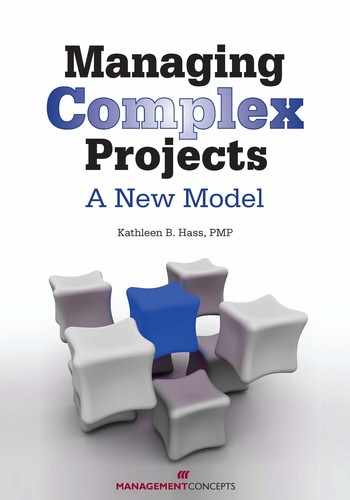Preface
I have been working in the project environment for more than 25 years. During that time I have developed a keen understanding of the degree of difficulty involved in managing projects of any size. As projects get bigger and more complex, we tend to “do more of the same,” applying ever greater degrees of rigor in the way of methods, reviews, and tests, resulting in higher costs but not necessarily returning value.
THE MOVEMENT HAS STARTED
It is now becoming clear that our conventional project management processes are inadequate for managing complex projects. Research is underway by the Project Management Institute and others to determine what makes projects complex and to learn how to manage project complexity. Many thought leaders in the field of project management are presenting alternative approaches for managing complex projects; many of these works are cited in this book.
So the movement has started. Unprecedented change is occurring all around us because of the global economy, the Internet, and the ubiquitous nature of information technology. Because projects are our means to execute strategies and react to changes in the marketplace, the capability to carry out project management effectively is no longer an option. If organizations are unable to execute projects, their very survival is likely to be at risk. Recognizing that the stakes are so high, we are beginning to redefine project success to be about delivering business value as opposed to simply delivering on time, on budget, and on scope. Yet, our ability to manage complex projects is immature and inadequate. We are now realizing that new approaches are desperately needed to manage complex projects in the ever-changing global economic environment.
INTRODUCING THE PROJECT COMPLEXITY MODEL
In this book we explore the nature of complexity theory as it applies to projects. We contend that complexity abounds in 21st century projects; that project teams are complex adaptive social systems nested within companies, which are in turn complex adaptive systems operating within the global economy (which is also a complex adaptive system); and that large-scale complex business solutions must be adaptive—easy to change as the business environment changes. Thus, our challenge is to learn how to employ complexity thinking as a complement to our conventional project management methods to manage 21st century projects.
This book presents a new model for project leadership teams to use to diagnose project complexity and to make decisions about how to plan and manage projects based on their complexity profile. Anyone challenged with filling a leadership role on a critical project will benefit from learning how to apply complexity thinking to make managerial decisions on projects.
It is no longer just about the project manager. Success depends on a combination of disciplines; therefore, complex projects must be led by a highly seasoned, multitalented senior team of strategic thinkers. The complex project leadership team should be made up of the best resources available—experienced project managers, business analysts, solution architects and developers, and a business visionary. The members of this project leadership team will collaboratively diagnose the dimensions of their project’s complexity using the new Project Complexity Model. Armed with an in-depth understanding of the nature of the complexities they are dealing with, they will be equipped to make managerial decisions about how to reduce and manage those complexities. As project success improves, we will all benefit.
HOW THIS BOOK IS ORGANIZED
In the Introduction we explore the current state of project performance. We look at the extent of, and reasons for, unprecedented change in the business environment. We then consider the track record for project performance—which is quite alarming—and present the case for finding new ways to think about and manage complex projects. The book is then divided into four parts.
Part One defines and explores the nature of complexity theory and complex adaptive systems, and suggests how complexity science can be applied to projects. We compare and contrast conventional project management techniques with adaptive approaches that use complexity thinking. We then introduce our Project Complexity Model and offer guidance on how to use the model to help manage complex projects.
Part Two suggests using the Project Complexity Model to inform decisions about project resource assignments. We provide an overview of the competencies required to manage complex projects, discuss strategies for developing managers of complex projects, and make recommendations for applying complexity thinking to select leaders of complex projects.
Part Three suggests using the Project Complexity Model to make decisions about the appropriate project cycle to use. We discuss and recommend appropriate project cycles for independent, low-risk projects; for moderately complex projects; and for highly complex projects.
Part Four is the heart of the book. We turn our attention to the nature of complexity dimensions, probe the causes of the different aspects of complexity, and offer suggestions for dealing with each complexity dimension using the Project Complexity Model. We then analyze all the dimensions of complexity delineated in the model, including large, long-duration projects; projects with multiple dispersed, diverse project teams; urgent projects; projects with unclear business problems, opportunities, or solutions; projects with volatile, ambiguous requirements; highly visible, politically sensitive projects; projects involving large-scale cultural change; projects dependent on external factors and constraints; and projects involving unproven IT technology.
Managing complex projects is no simple matter. We hope our Project Complexity Model will shed some light and provide some helpful direction for you in your quest to manage the particular complexities of your project.
Kitty Hass
Castle Rock, Colorado
